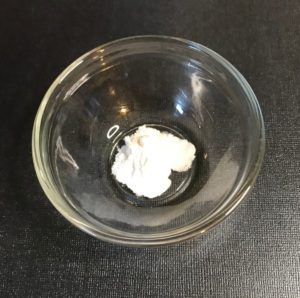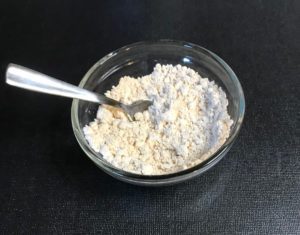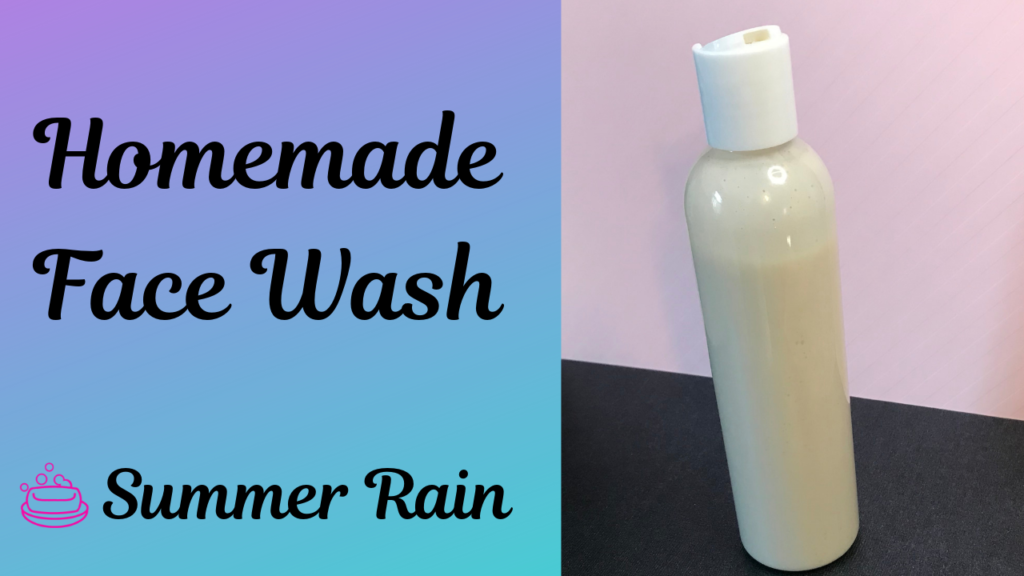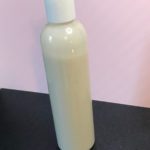In this post I am going to teach you how to make your own homemade face wash. This face wash is great for cleansing the oil from your skin and leaves it feeling clean and refreshed. I started making it a few months ago and it has cleared up my acne. I have also begun to notice some of the old acne scars are fading!
Table of Contents
Prefer to watch this project instead of reading it?
Although I do make my own cold process soap, this is not what I use to cleanse my face. I only use that to wash my body. In a face wash, I want a good cleansing that will remove dirt and oil. I have chosen all of my ingredients for clearing up acne, fading acne scars, reducing inflation and it is suitable for sensitive skin.
Some links are affiliate links because I am an associate and earn a small commission on them.
How to clean your face naturally?
The term ‘natural’ really means nothing legally for cosmetics. The FDA does not have any regulations on the word natural and no definition set as of right now. When I use the term ‘natural’ in this recipe, I mean that it does not contain any synthetic ingredients.
With that definition, this face wash is all natural. Decyl Glucoside is made from reacting cornstarch glucoside with natural fatty acids. It is certified organic and biodegradable. It is a sugar based cleanser that is sourced from renewable resources.
What is a surfactant and why do we need it?
Let’s start by going over what a surfactant is. A surfactant is the cleanser in this homemade face wash.
And the surfactant also helps with wetting your face. Water is attracted to water (does that make sense?) The easiest way to explain what ‘wetting’ is, is to think of water in a spray bottle. If you were to spray it on a window, it would create drops of water that stick together.
Now, think of how when you spray window cleaner on the window the water does not stick together. Instead it sprays out and covers the entire window. This is because a surfactant is helping with wetting the window by getting the water not to stick together in drops.
This is because our surfactant is lowering the surface tension of the water, thus increasing the wetness. We need the wetting, because the water needs to be able rise the dirt and oil from our skin.
Our surfactant is a non-ionic surfactant. This means that this particular surfactant is gentle on the skin. It is not a surfactant that creates a lot of bubble when washing, it has medium bubbling properties. Personally, I don’t love my face wash to get all bubbly because it tends to get in my eyes.
Remember, that if you need a more powerful or super bubbly face wash, you can definitely add another surfactant. Since our surfactant is non ionic, it works well with most other surfactants.
Ok, that is a lot to take in. The rest of the ingredients are easier to understand and ones that you are probably more familiar with.
Active Matter in Homemade Face Wash
Active What? When we are using a surfactant we want to be sure that we are not using too much. Surfactants are used in all sorts of things from shampoo, household cleaners and laundry soap. You are not going to need as much in a face wash as you would in a household cleaner.
To calculate the active matter you take the active matter provided by your supplier. This is the amount of the actual surfactant in it, the rest is water. The one I am using has an active matter of 54%.
Then you will take the percentage that you are using in your recipe. We are using 3% in this recipe.
You will multiple the 54 x .03 (or 3%) to find the active matter. For this recipe it is 1.62.
For a face wash, the rule of thumb is to have an active matter below 10%. If you need to you can increase the surfactant and decrease the difference from the distilled water.
Water Phase Ingredients:
Distilled water
Yes, it has to be distilled. You are spending the time and effort to make your own homemade face wash, you don’t want to mess it up with your water. About a gallon of distilled water is about a dollar where I live. Remember that all tap water is not created equal. By using distilled, you will have a consistent product at all times.
Vegetable glycerin
I think by now you know my love for vegetable glycerin as I put in just about everything that I can. The reason why it is such an amazing ingredient is that it draws moisture to our skin. Moisture is extremely important for our face, in fact not having enough moisture can make wrinkles look worse and make you skin appear dull and flaky.
Xanthan Gum
Xanthan gum is used in this cleanser to increase the viscosity of the face wash and to stabilize the emulsion. Although this is used to thicken our face wash, it is able to do so without loosing any of the foaming properties.

Colloidal Oatmeal
Colloidal oatmeal is the powder that is formed from grinding whole wheat grains. This is used since it is known to soothe blemished, stressed and irritated skin.

Oil Phase Ingredient:
Olive Oil
I love olive oil for my face. This is packed with antioxidants that help to fight environmental damages.
Cool Down Ingredients:
Decyl Glucoside
Decyl glucoside is our non ionic surfactant that will increase wetting and provide a gentle cleansing.
Tea Tree Oil
Tea tree oil basically does everything. Ok, not everything but tea tree oil helps to reduce blemishes. It has anti-bacterial properties. It can help with clearing up acne, as well as reducing inflammation when you have breakouts.
Lavender Essential Oil
Lavender essential oil is said to have antiseptic and antibacterial properties. It can help to unclog your pores and to prevent and heal breakouts.
Chamomile Essential Oil
Chamomile essential oils contains azulene, which is proven to help moisturize and reduce inflammation. Also said to be able to fight free radicals that can age our skin.
Broad Spectrum Preservative
Anytime you have a product that contains water, you must use a broad spectrum preservative. If you don’t you are going to have all kinds of nasty bacteria growing in your product. I am using optiphen plus in this recipe.
Homemade Face Wash
Equipment
- 2 heat safe containers
- Double boiler or sauce pan with a silicone pad on the bottom
- Immersion Blender
- Thermometer
- Container to store face wash
- Scale to weigh ingredients
- Container with a pouring spout (optional but makes it easier to get face wash into your container)
Ingredients
Water Phase
- 5.57 ounce | 69.70% Distilled Water
- 0.52 ounce | 6.5% Vegetable Glycerin
- 0.04 ounce | 0.5% Xanthan Gum
- 0.72 ounce | 9% Colloidal Oatmeal
Oil Phase
- 0.64 ounce | 8% Olive Oil
Cool Down Phase
- 0.08 ounce | 1% Broad Spectrum Preservative
- 0.40 ounce | 5% Deycl Glucoside
- 0.01 ounce | .10% Tea Tree Oil
- 0.01 ounce | .10% Lavender Essential Oil
- 0.01 ounce | .10% Chamomile Essential Oil
Instructions
- Heat water phase ingredients in a double boiler
- At the same time heat oil phase ingredients in a double boiler
- After both water and oil phase have heated, mix them together with an immersion blender.
- Add all cool down ingredients, except the preservative and mix.
- After the face wash is below 120° F, add the preservative
- Pour the mixture into your container.
- Allow to cool completely before placing the lid on the container.
- Enjoy you face wash!
Let me know what other recipes you are interested in. Are you in need of a good facial moisturizer? A make up remover?


Comments are closed.